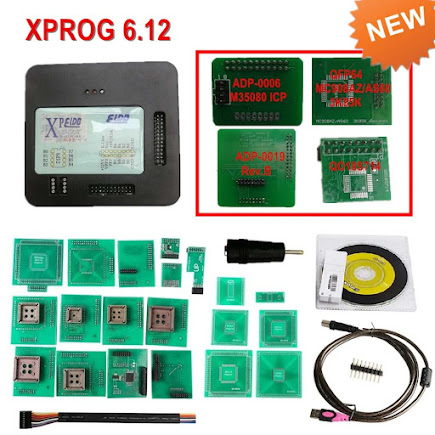ECU Virtual Read
Unlocking the Power of Automotive Control Units
One crucial component that plays a significant role in a car's performance is the Engine Control Unit (ECU). The ECU is responsible for managing various aspects of the engine, such as fuel injection, ignition timing, and emission control. Over the years, automotive enthusiasts and professionals have sought ways to optimize the performance of their vehicles, leading to the development of ECU tuning techniques. One such technique is ECU Virtual Read,which allows for the modification of the ECU's parameters to enhance a car's performance. In this blog post, we will delve into the intricacies of ECU Virtual Read, exploring its benefits, process, and impact on the automotive industry.
Understanding ECU Virtual Read
ECU Virtual Read is a method used to extract data from an ECU without physically accessing it. Traditionally, to modify an ECU's paraeters, mechanics would need to physically remove the ECU from the vehicle and connect it to a computer for programming. However, with ECU Virtual Read, the need for physical access is eliminated, making the process more convenient and efficient.
Benefits of ECU Virtual Read
-
Convenience: ECU VR file offers a significant advantage in terms of convenience. Since the ECU can be accessed remotely, there is no need to remove it from the vehicle, saving time and effort. This is particularly beneficial for automotive professionals who work on multiple vehicles or for enthusiasts who want to experiment with different tuning options.
-
Cost-Effective: By eliminating the need for physical access, ECU Virtual Read reduces costs associated with labor and equipment. Mechanics can perform tuning procedures without the need for specialized tools or extensive disassembly, resulting in cost savings for both professionals and car owners.
-
Non-Invasive: ECU Virtual Read is a non-invasive method that does not require any modifications to the vehicle's hardware. This means that the original ECU remains intact, preserving the vehicle's warranty and ensuring that it can be easily reverted to its original state if desired.
The Process of ECU Virtual Read
-
Diagnostic Tool Connection:To perform Virtual Read, a diagnostic tool is connected to the vehicle's OBD-II (On-Board Diagnostics) port. The OBD-II port is a standardized interface found in most modern vehicles, allowing for communication between the vehicle's ECU and external devices.
-
Data Extraction: Once the diagnostic tool is connected, it communicates with the ECU and extracts the necessary data. This data includes information about the engine's performance, fuel injection, ignition timing, and other relevant parameters.
-
Data Analysis: After the data is extracted, it is analyzed using specialized software. This software allows automotive professionals to interpret the data and make informed decisions regarding the tuning parameters.
-
Parameter Modification: Based on the analysis, the tuning parameters are modified to optimize the vehicle's performance. These modifications can include adjustments to fuel injection timing, air-fuel ratio, turbo boost pressure, and other relevant parameters.
-
Data Writing: Once the tuning parameters are finalized, they are written back to the ECU using the diagnostic tool. This process ensures that the modified parameters are stored in the ECU's memory and will be used during the vehicle's operation.
Impact on the Automotive Industry
ECU Virtual Read has had a significant impact on the automotive industry, particularly in the realm of performance tuning. Here are some key areas where its influence can be observed:
-
Performance Enhancement: ECU Virtual Read allows automotive enthusiasts to unlock the full potential of their vehicles. By fine-tuning the ECU's parameters, they can achieve improved engine performance, increased horsepower, and enhanced throttle response. This has made ECU Virtual Read a popular choice among car enthusiasts who seek to optimize their vehicle's performance on the road or track.
-
Fuel Efficiency: In addition to performance enhancements, ECU Virtual Read can also be used to improve fuel efficiency. By optimizing the fuel injection timing and air-fuel ratio, mechanics can ensure that the engine operates at its most efficient level, resulting in reduced fuel consumption and lower emissions.
-
Customization: ECU Virtual Read offers a high degree of customization, allowing car owners to tailor their vehicle's performance to their specific preferences. Whether it's adjusting the throttle response, modifying the shift points in an automatic transmission, or fine-tuning the turbocharger's boost pressure, ECU Virtual Read provides the flexibility to create a personalized driving experience.
-
Diagnostic Capabilities: ECU VR read also enhances the diagnostic capabilities of automotive professionals. By accessing the ECU's data, mechanics can identify and troubleshoot potential issues more efficiently. This leads to faster diagnosis and repair, reducing downtime and costs for both professionals and car owners.
Summary
ECU Virtual Read has revolutionized the way automotive professionals and enthusiasts optimize the performance of their vehicles. By eliminating the need for physical access to the ECU, this method offers convenience, cost-effectiveness, and non-invasiveness. Through the process of data extraction, analysis, parameter modification, and data writing, ECU Virtual Read allows for performance enhancements, improved fuel efficiency, customization, and enhanced diagnostic capabilities. As the automotive industry continues to evolve, ECU Virtual Read will undoubtedly play a crucial role in unlocking the full potential of vehicles and satisfying the desires of car enthusiasts worldwide.



Comments
Post a Comment